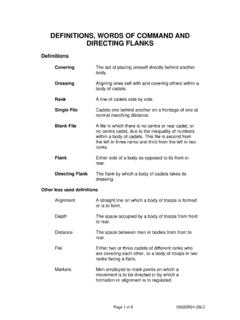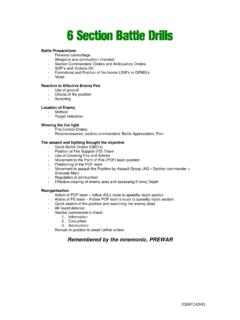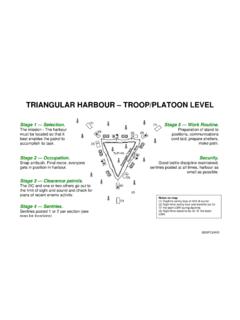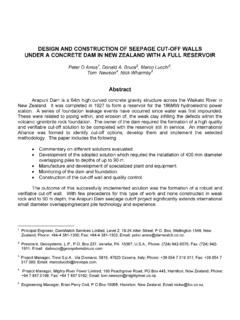Transcription of Aiming Off for Elevation and Direction - …
1 Aiming Off for Elevation and Direction POAPOIC orrected POAPOIPOIC orrected POAC orrected POA Aiming Off for Wind 0204 SAA06HO FIRING FROM OTHER POSITIONS The Kneeling Position Rest Firing Alert The Sitting Position (Legs Crossed) Rest Firing Alert The Sitting Position (Legs Apart) Rest Firing Alert 0204 SAA07-08HO Use of Cover Fire Positions The ideal fire position offers: Free use of personal weapons and grenades. Protection against HE and small arms fire. Cover from view and a concealed route in and out. An unobstructed view of a wide and deep arc of fire. Use of Cover Do not rest the barrel as this will displace the shots fired. Use the right side of the cover.
2 Firing from the left shoulder is dangerous. Always try to rest the forearm and elbows. If the forearm cannot be supported, rest the back of the hand on the cover. Failing that, rest the hand guard on the cover, keeping the hand as close to it as possible. No matter how cover is used, the four marksmanship principles are to be applied. Muzzle and Ejection Clearance The sight line on the rifle is high in relation to the axis of the bore. It is possible to achieve a clear line of sight to the target and at the same time have the barrel obstructed by cover. Obstruction may be less apparent a few metres in front of the position than directly in front of the muzzle. Solid cover, close to the weapon, obstructs clear ejection; the cases may bounce up into the face of the firer or back into the weapon causing injury or a stoppage. 0204 SAA09-10HO Carriage of the Weapon Moving With the Weapon The basic carrying positions are suitable when the cadet is upright; when crawling he/she may have to adopt different techniques.
3 When moving with the weapon: Keep the muzzle out of the dirt. Keep the sights off the ground; try and protect them with the forearm using an underhand grip. Try to keep the cocking handle uppermost. The dust cover should be closed. The cadet is responsible for the safe handling of his weapon and is to ensure that it is in the Made Safe or Unloaded state before moving or changing position. THE HIGH PORT POSITION This position is used when going through scrub or when crossing obstacles. If the cadet stumbles when using this position, the muzzle of the weapon will not get entangled, nor get filled with dirt, nor point at his comrades. THE LOW PORT POSITION It is used when the tactical situation does not necessitate the use of the High Port or Alert positions, in particular when one hand is needed to be used for searching personnel, checking documents or moving a barrier.
4 THE ALERT POSITION This position is used so that the rifle can be used instantly. 0204 SAA11HO Reaction to Effective Enemy Fire On the command Take cover Dash Dash towards the nearest cover or the cover previously indicated by the section commander. Down, Crawl Get down and crawl into the position and observe. Keep the weapon behind cover. Sights, Observe Check that the sight is correctly set and fire at any visible enemy or target indicated by the section commander. Fire! Actions on the commands Ready , Fire , Watch and shoot , Go on , Make safe , are the same as for firing in the open. Keep behind cover as much as possible and vary your position. During any lull in firing, refill magazines from behind cover. On the command Prepare to advance or Prepare to move , the weapon is to be Made safe.
5 Make sure that magazines are complete and that there is sufficient ammunition in the magazine on the rifle, pouches are fastened and that sights are at 300 metres (the battle setting). On the command Advance , or Move , break cover from a different place from that in which firing took place, and advance in the Direction and in the formation indicated. 0204 SAA12HO Visibility Visual training is training in observation and concealment. To OBSERVE is to see through the enemy s CONCEALMENT; to CONCEAL yourself is to defeat his OBSERVATION. Once you are trained in both you can find and engage the enemy without being seen. You can find out a lot about the enemy by watching him; by concealing yourself you can deceive him and, if he attacks, you can meet him with short range fire where he least expects it. The important things are: See without being seen.
6 Notice details. Learn to understand the meaning of what you see, and make the right deductions. WHY THINGS ARE keep in the shadow of a bigger object Don t stand against a skyline Don t look different from your surroundings Disguise your shape (especially your Equipment). Keep spread out - but not too regularly Move carefully 0204 SAA13HO The Unit of Measure Method (AKA The Football Pitch Method) Take 100 metres, or any smaller better recognized distance as your unit and see how many units you can fit in between yourself and an object. Ranges are marked out at one hundred meter intervals A full size Football pitch is approximately one hundred meters Once you know what 100m looks like see how many you can fit between you and the target However don t you the unit of measure method Its over 400 meters.
7 If you can t see all of the ground between you and the target. 0204 SAA14HO The Appearance Method Another method of judging distance between you and an object is to study what it looks like compared with its surroundings; this is called the appearance method. It takes a lot of practice under varying conditions to become good at it. The amount of visible detail of a cadet at various ranges gives a good indication of the distance he is away: At 100 metres clear in all detail. At 200 metres clear in all detail, colour of skin and equipment identifiable. At 300 metres clear body outline, face colour good, remaining detail blurred. At 400 metres body outline clear, remaining detail blurred. At 500 metres body begins to taper, head becomes indistinct. At 600 metres body now wedge shaped, no head apparent. Things Closer Further Away The light is bright or the sun is shining from behind you.
8 They are bigger than other things around them. There is dead ground between them and you. They are higher up than you are. The light is bad or the sun is in your eyes. They are smaller than other things around them. You are looking across a valley or down a street or a ride in a wood. You are lying down. 0204 SAA15HO Aids to Judging Distance Key Ranges. If you know the range to any point in your arc you can estimate the distance to other objects from it. Halving. Choose a point that you think is halfway to your target; estimate the distance to that point and double it. Bracketing. Say to yourself The target could not be more than x metres, nor less than y metres away , add x to y and halve the result; the answer is the range. For instance, if x is 300 and y is 100, the range is about 200. The farther the target is away the wider should be your bracket.
9 0204 SAA16HO Elementary Observation The normal way to search ground is to divide it into foreground, middle distance and distance, and search each of them, in that order, from right to left. In that way you are sure that you do not leave out any of the ground; but there are other ways of dividing the ground up which may sometimes be better, particularly if the ground is very broken. The ground may be divided into arcs, left or right of a specified centre line. Areas that are likely to be occupied by the enemy may be specially indicated for thorough searching. Scanning. 1. Divide the area into foreground, middle distance and distance. 2. Scan each area horizontally starting with the foreground 3. When horizontal scanning is completed, scan along the line of any features which are angled away from the observation position. Searching. 1. Searching may take place at any stage during.
10 2. Search for each of the factors of why things are seen in turn 3. Search across hedgerows or a row of trees, not along them. 0204 SAA17HO Target Indication Target indication enables you to quickly and effectively describe a targets location to the other members of your section, or quickly and effectively visually identify a target being indicated to you by someone else. The Direct Method Used for obvious targets on or near the lines shown. Remember to tell the section where the axis line is. Reference Points If prominent objects are clearly visible a farm house or loan trees, these can be given a specific name or reference so that the whole section can quickly visually locate them. Clock Ray Method 126395410112187 Remember to place the clock face on a reference point and not imagine yourself as the centre. 0204 SAA18-19HO GG roup Section, Delta Fire Team, Gunners RR ange 100, 200, 300, 400, 500 II ndication Half Left, Right Side of House TT ype of fire Rapid, Watch and Shoot, Ripple, Burst Full Orders Gun Group 400 Right House Doorway Busts Fire.
















